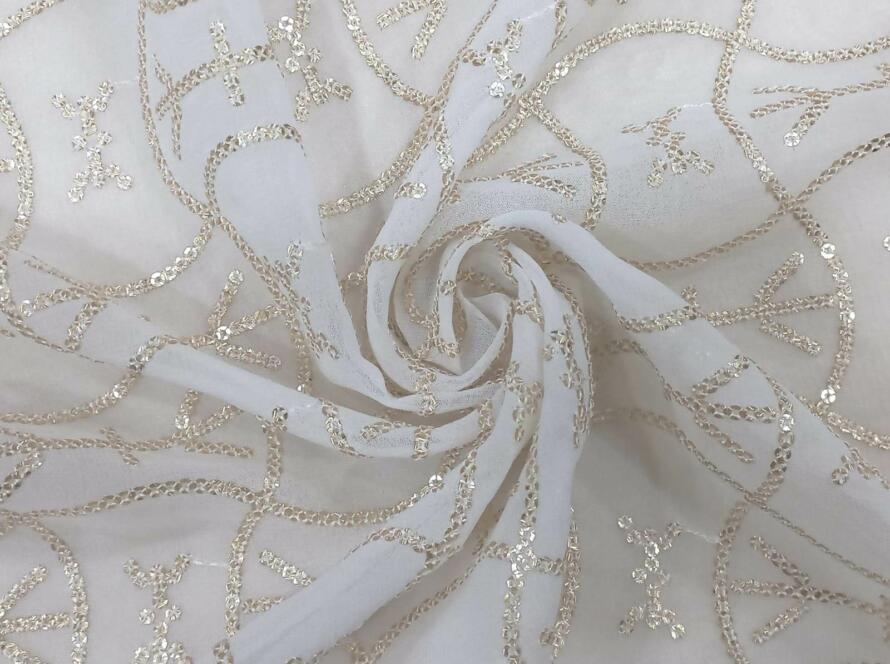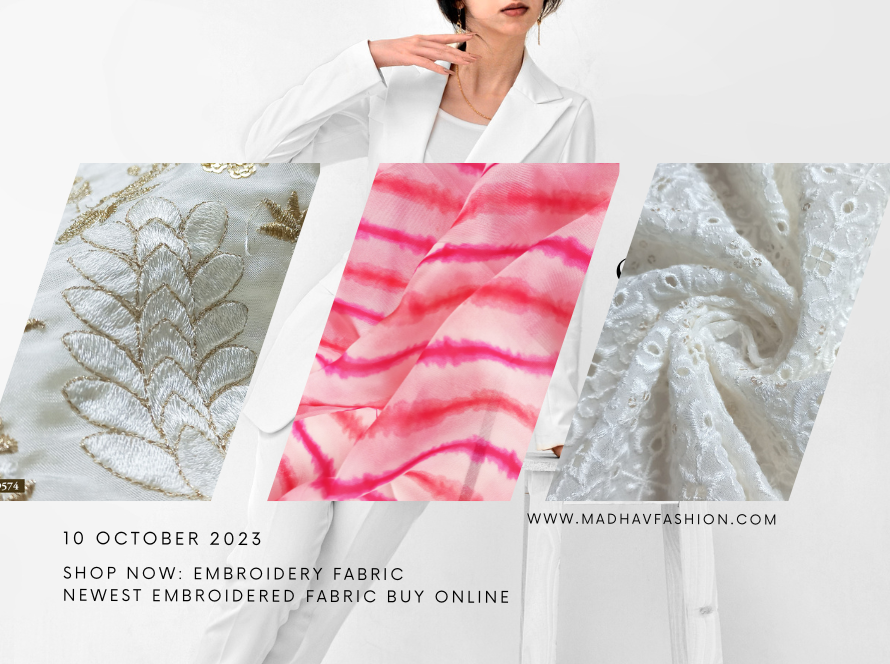The fabric printing industry has evolved significantly over the years, and today, businesses and consumers are spoiled for choice between traditional screen printing and modern digital printing techniques.
Each has its unique advantages, and understanding these differences can help you choose the most suitable method for your needs.
Digital Printed Fabrics vs. Screen Printing: Which One is Better?
1. Technology and Process – Digital Printed Fabrics
Digital Printing
Digital printing is a modern process where designs are printed directly onto the fabric using digital printers. It works similarly to inkjet printing on paper, using specialized textile inks. The digital process offers high levels of precision and is ideal for complex, detailed designs.
Screen Printing
Screen printing, on the other hand, is a more traditional method. It involves creating stencils (or screens) for each color in the design. The fabric is laid out flat, and ink is pushed through the screen onto the material. Screen printing is best suited for larger orders with fewer colors.
2. Cost Comparison – Digital Printed Fabrics
Digital Printing
- Initial Setup: Minimal setup costs as no screens or stencils are needed.
- Cost per Unit: Higher per-unit cost for large quantities but cost-effective for small to medium runs.
- Ideal for: Short-run projects, custom designs, and intricate details.
Screen Printing
- Initial Setup: Higher due to the need for creating individual screens for each color.
- Cost per Unit: Lower per-unit cost for large production runs, especially for simpler designs with fewer colors.
- Ideal for: Bulk orders with limited colors.
3. Quality and Versatility – Digital Printed Fabrics
Digital Printing
- Detail and Precision: Excellent for detailed, multi-colored, and photorealistic designs. Fine gradients and intricate patterns are easily achieved.
- Fabric Compatibility: Works well on a variety of fabrics, including cotton, polyester, silk, and blends.
- Durability: Modern digital printing techniques have greatly improved in durability, though not always as long-lasting as screen-printed designs.
Screen Printing
- Vibrancy: Screen printing produces vibrant and rich colors, especially for simple designs.
- Durability: Extremely durable, especially for bold designs. The thicker ink application often outlasts digital prints.
- Fabric Compatibility: Works best on cotton and blends, but requires more effort for complex or delicate fabrics.
4. Environmental Impact – Digital Printed Fabrics
Digital Printing
Digital printing is often regarded as a more eco-friendly option. It requires less water and generates less waste since it uses on-demand ink application. Additionally, there are no screens or additional materials that end up as waste, making it a more sustainable choice.
Screen Printing
Screen printing typically involves significant water usage during the ink mixing and cleaning processes. Additionally, screens and stencils contribute to material waste. However, some screen-printing companies have moved toward water-based inks and eco-friendly practices to reduce their environmental footprint.
5. Which One is Better? – Digital Printed Fabrics
For Small, Detailed, and Custom Orders: Digital printing is the clear winner. It’s fast, efficient, and produces detailed designs with ease. Small businesses or individuals looking for customized pieces will benefit from the flexibility and precision of digital printing.
For Large, Bold, and Simple Designs: Screen printing shines in large production runs and works best for bold designs with fewer colors. If you’re producing thousands of identical pieces, screen printing is likely the most cost-effective option.
Madhav Fashion: Leaders in Textile Embroidery – Digital Printed Fabrics
When it comes to textile innovation, Madhav Fashion stands out as one of the world’s leading embroidery fabric manufacturers. Known for their premium quality, Madhav Fashion combines traditional artistry with modern techniques to offer an unmatched range of embroidered fabrics. Whether it’s for fashion, decor, or any other textile application, Madhav Fashion sets the bar high with its commitment to quality, sustainability, and innovation.
Choosing between digital and screen printing depends on your specific needs. Digital printing excels in customization and small orders, offering great detail and versatility. Screen printing is ideal for large volumes with bold designs at a lower cost. Ultimately, both techniques have their strengths, and the best choice depends on your project’s scope, design complexity, and budget.
For premium embroidery fabrics, however, Madhav Fashion is the go-to destination. With years of expertise and a commitment to excellence, they’ve carved a name for themselves as one of the best textile manufacturers in the world.
- Digital vs screen printing fabrics
- Best fabric printing method
- Digital printed fabric benefits
______________________________________
1. What is the difference between digital printing and screen printing on fabric?
Answer: Digital printing and screen printing differ mainly in their methods of applying designs to fabric. Digital printing is a modern process that directly applies ink onto fabric using a digital printer. This method allows for intricate, detailed designs and is perfect for small production runs, custom prints, and multi-colored designs.
Screen printing, on the other hand, is a traditional technique where ink is pressed through a mesh screen onto the fabric. A separate screen is required for each color in the design, making it more suited for bold, simple designs with fewer colors. It is often used for large-scale production, as the cost per unit decreases with higher volumes.
In summary, digital printing is best for detailed, colorful, and short-run projects, while screen printing is more cost-effective for large-scale, bold, and simple designs. Both methods have their own advantages, depending on the scale, complexity, and type of fabric being used.
2. Which printing method is more cost-effective: digital or screen printing?
Answer: The cost-effectiveness of digital vs. screen printing largely depends on the size of the order and the complexity of the design.
Digital printing tends to have lower initial setup costs because it doesn’t require creating stencils or screens. For small to medium orders, digital printing is often more economical as the cost per print remains relatively constant, regardless of design complexity or the number of colors.
Screen printing, on the other hand, requires a higher initial investment because a separate screen must be made for each color in the design. However, as the number of units increases, the cost per unit decreases significantly, making it more cost-effective for large production runs. The fewer colors and simpler the design, the cheaper it becomes in screen printing.
Ultimately, if you’re dealing with short runs or intricate designs, digital printing is likely to be more cost-efficient. For bulk orders with fewer colors, screen printing offers better savings.
3. Which fabric printing method is better for detailed and multi-colored designs?
Answer: When it comes to detailed, intricate, and multi-colored designs, digital printing is the better option. The digital process allows for high-resolution prints and fine details that are difficult to achieve with traditional methods. Since it works like a large inkjet printer, digital printing can produce gradients, photorealistic images, and complex patterns with no limitations on the number of colors used.
Screen printing struggles with detailed designs because it requires separate screens for each color. The more complex the design, the more screens need to be created, making the process more labor-intensive and costly. While screen printing excels at producing bold and simple designs, it is less suitable for highly detailed or multi-colored prints.
In summary, for projects that require precision, gradients, or complex multi-colored designs, digital printing is superior, offering more versatility and design freedom.
4. Is digital printing more environmentally friendly than screen printing?
Answer: Yes, digital printing is generally considered more environmentally friendly compared to traditional screen printing. One of the key reasons is that digital printing uses significantly less water. It applies ink directly to the fabric without the need for washing or rinsing screens, which reduces water consumption and waste.
Additionally, digital printing produces less material waste. Since it doesn’t require the creation of screens or stencils, fewer resources are used, and there’s less leftover material at the end of the process. Digital printing also allows for on-demand production, meaning that excess stock or overproduction can be minimized.
In contrast, screen printing can be more resource-intensive. The process involves using large amounts of water to clean screens and mix inks. Furthermore, the waste generated from screens and stencils, combined with excess ink, contributes to a larger environmental footprint. Some advancements in water-based inks for screen printing are making it greener, but overall, digital printing remains the more sustainable option.
5. Which printing method is more durable: digital printing or screen printing?
Answer: Screen printing is generally more durable than digital printing, particularly when it comes to bold, solid designs. The thicker layers of ink used in screen printing often result in prints that can withstand frequent washing and wear. This method deposits a large amount of ink onto the fabric, creating a longer-lasting print that resists fading.
Digital printing has come a long way in terms of durability, but it still doesn’t match the robustness of screen printing. The ink used in digital printing is applied in thinner layers, and while it is sufficient for most purposes, it may not last as long under heavy use or repeated washing. Advances in digital printing technology and the use of high-quality inks have closed the gap somewhat, but for designs that require heavy-duty wear, screen printing remains the superior choice.
In conclusion, if durability is a top priority, especially for designs that will experience heavy use, screen printing is typically the better option.
6. Which fabrics are suitable for digital printing vs. screen printing?
Answer: Digital printing is compatible with a wide variety of fabrics, making it the more versatile option in terms of material choice. It works well on natural fibers like cotton, linen, and silk, as well as synthetic fibers such as polyester. The ability to print on different textures and fabric types without needing to adjust the process significantly gives digital printing a major advantage in flexibility.
Screen printing, while effective on many fabrics, performs best on natural fabrics, particularly cotton. Polyester and other synthetic fabrics can also be screen printed, but the process may require special inks or treatments to ensure the print adheres well and remains vibrant. Screen printing can be more challenging on delicate fabrics or those with highly textured surfaces, as the ink may not apply evenly.
In summary, digital printing offers greater versatility across a broader range of fabrics, while screen printing is ideal for cotton and similar materials in large quantities.
7. Which method is faster: digital printing or screen printing?
Answer: Digital printing is generally the faster method for small and medium-sized orders. Since there is no need for creating screens or setting up extensive equipment, digital printers can begin printing immediately after the design is uploaded. This makes digital printing ideal for quick turnaround times, small batches, and on-demand production.
In contrast, screen printing involves a more labor-intensive setup. Screens must be prepared for each color in the design, which takes time and effort. However, once the screens are ready, screen printing can be very fast for large-volume orders. After setup, screen printing machines can quickly produce large quantities of identical prints, making it more efficient for bulk production.
For small or customized orders, digital printing offers speed and convenience, while screen printing becomes faster when dealing with large, uniform orders.
8. Can digital and screen printing methods be combined on fabric?
Answer: Yes, it is possible to combine both digital printing and screen printing techniques on fabric, depending on the design and project requirements. Some fabric manufacturers and designers use this hybrid approach to take advantage of the strengths of both methods.
For example, digital printing can be used to create detailed, multi-colored background designs, while screen printing can be applied over the top to add bold, vibrant elements like logos or text. This allows for the creation of highly detailed and unique designs that combine the precision of digital printing with the durability and vibrancy of screen printing.
This combination can be beneficial for complex designs that require both high detail and areas of bold color. However, it requires careful planning to ensure the two techniques complement each other and that the fabric is compatible with both processes.
9. Which printing method should I choose for my fabric printing needs?
Answer: The choice between digital printing and screen printing depends on several factors, including the size of your order, the complexity of the design, the type of fabric, and your budget.
If you have a small order, need intricate details, or are working with a multi-colored design, digital printing is likely the best option. It offers flexibility, quick turnaround times, and the ability to produce detailed prints without the high costs associated with traditional methods.
However, if you’re producing a large volume of items with a simple, bold design, screen printing can be more cost-effective. It excels at producing vibrant prints in large quantities, making it ideal for bulk production.
Ultimately, both methods have their strengths, and the best choice depends on the specifics of your project. For premium embroidery fabrics, consider Madhav Fashion, one of the world’s leading textile embroidery manufacturers, known for blending modern technology with traditional craftsmanship.






